Only days after being found in human blood, researchers have now identified microplastics stuck deep in the lungs of living people for the first time. The tiny pieces of plastics measuring five millimeters or less were found in almost all the samples analyzed, with the researchers surprised by the high number of particles found.

Microplastics are present in all environments, from marine and freshwater bodies, to the soil, food, drinking water, and air. They form when plastics break down and during commercial product manufacturing and have become a leading environmental problem, with not a lot of certainties so far over their effect on human health.
Microplastics have been found in the placentas of pregnant women. Studies in pregnant rats have shown that microplastics pass fast through the lungs into the hearts, brains, and other organs of the fetuses. Last week, researchers detected microplastics of four common plastics in blood samples of healthy adults.
Consequentially, there is an increasing concern regarding the hazards associated with microplastic ingestion, dermal contact, and inhalation. Now, researchers decided to further explore the presence of these tiny particles in live human lungs, after a study in 2021 on autopsy samples found microplastics in 13 of the total 20 people analyzed.
“We didn’t expect to find the highest number of particles in the lower regions of the lungs, or particles of the sizes we found,” Laura Sadofsky, senior author of the study, told The Guardian. “It’s surprising as the airways are smaller in the lower parts of the lungs and we would have expected particles of these sizes to be filtered or trapped.”
Microplastics and lungs
Sadofsky and her team obtained human lung tissue samples from 13 patients undergoing surgery at Castle Hill Hospital in the UK. Samples were collected from the upper, middle, and lower areas of the lung, which were frozen and placed into glass containers with foil lids until bulk analysis was conducted at a laboratory.

A total of 39 microplastics were identified within 11 of the 13 human lung tissue samples. All male samples contained at least one microplastic particle, whilst two of the five female samples didn’t. Researchers argue this could be because female airways are significantly smaller than the ones of males, limiting microplastic intake.
Of the microplastics detected in the study, 12 polymer types were identified. Polypropylene (23%), used in plastic packaging and pipes, polyethylene terephthalate (18%), used in bottles, resin (15%), used in pharmaceuticals and food packaging materials, and polyethylene (10%), used in grocery bags, were the most abundant.
While the path of ultrafine particles entering the lung due to pollution, and their resulting biological effects in terms of inflammation responses, are well established, the same can’t be said of microplastics, which is why the researchers are calling for further studies into this topic.
“Airborne microplastics are globally ubiquitous and especially prevalent indoors where humans spend many hours a day,” the researchers wrote. “It’s the smallest and least dense microplastic particles that are the most cause for concern regarding respiratory health, as these are most likely to deposit within the lungs based on aerodynamic diameter.”
The study was published in the journal Science of the Total Environment.



